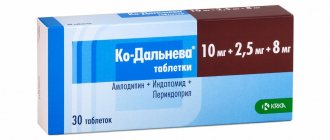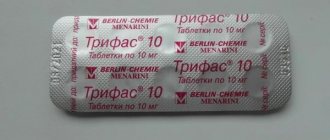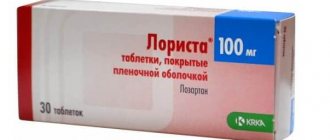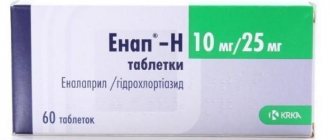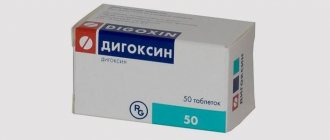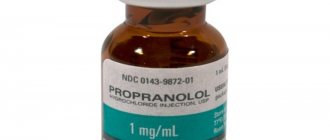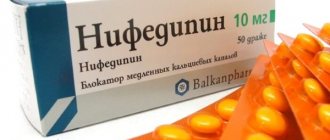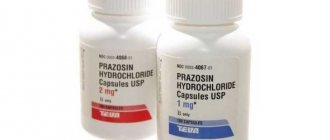Verapamil (tablet form) belongs to the category of calcium channel blockers. The instructions for use highlight the following features:
How to dissolve vascular plaques, normalize blood circulation, blood pressure and forget the way to the pharmacy
- Sold only with a doctor's prescription
- During pregnancy: contraindicated
- When breastfeeding: contraindicated
- In childhood: contraindicated
- For liver dysfunction: with caution
Pharmacodynamics and pharmacokinetics
Pharmacodynamics
The pharmacological group of drugs that Verapamil belongs to are calcium channel blockers. They have antiarrhythmic, hypotensive and antianginal effects. The mechanism of action is associated with the blockade of “slow” calcium channels, which are located in the myocardial cells, cardiac conduction system and vascular smooth muscle cells. In addition, these channels are present in the smooth muscles of the urinary tract, bronchi and uterus. As a result of the blockade, the pathologically increased flow of calcium ions into the cells is normalized. By reducing the transmembrane entry of Ca2+ into cardiomyocytes, the drug reduces the strength of myocardial contractions and heart rate, and, consequently, the myocardial oxygen demand decreases.
Reduces the muscle tone of the vascular wall and causes dilatation mainly of arterioles, which leads to a decrease in resistance in the systemic circle and a decrease in afterload. It also increases coronary blood flow. It slows down AV conduction and inhibits the automatism of the sinus node, which makes it possible to use it for the treatment of supraventricular arrhythmias.
Verapamil has a more pronounced effect on the conduction system (sinus and atrioventricular node), and the effect on blood vessels is less pronounced. Improves kidney excretory function. It should be remembered that the drug aggravates heart failure, provokes severe bradycardia and atrioventricular block.
Pharmacokinetics
Almost completely absorbed from the gastrointestinal tract. The maximum concentration in the blood is determined after 1-2 hours. 90% binds to blood proteins. Rapidly metabolized in the liver. During a course of treatment, the effect increases, which is associated with the accumulation of the drug and its metabolites.
The half-life for a single dose is 3-6 hours, for a long-term dose it is up to 12 hours. Excreted through the kidneys (about 74%).
Pharmacological properties
Verapamil reduces the oxygen demand of the heart muscles by reducing contractility and heart rate. Subsequently, the coronary vessels dilate and blood flow increases. The tone of peripheral capillaries worsens.
The drug has a pharmacological effect in supraventricular arrhythmia by suppressing the automaticity of the sinus node. To prevent the medication from causing harm, it is necessary to exclude contraindications before use.
Side effects
Most common adverse reactions:
- bradycardia;
- pronounced decrease in blood pressure;
- dizziness and headache;
- nausea, constipation;
- facial redness;
- increase in body weight.
Less common adverse reactions:
- diarrhea;
- gum hyperplasia;
- nervousness;
- fatigue;
- lethargy;
- skin itching, rash;
- AV block III stage, with rapid intravenous administration;
- agranulocytosis, thrombocytopenia;
- galactorrhea, gynecomastia;
- arthritis;
- peripheral edema;
- pulmonary edema.
Features of use
When treating with Verapamil, it is necessary to constantly monitor the following:
- The work of the respiratory organs.
- For the functions of the cardiovascular system.
- Blood glucose level.
- The amount of electrolytes.
- Regularly determine the total blood volume in the vessels and daily diuresis.
The drug "Verapamil" is able to prolong the PQ interval if the concentration of the active substance in the blood is above 30 ng/ml.
Stopping treatment suddenly is not recommended.
During treatment with the drug, you should avoid work associated with increased concentration of attention, as well as driving vehicles - a decrease in reaction speed is possible. The medicine should not be used by pregnant women and women during lactation. The active substance can penetrate the placental barrier and also enter breast milk.
Instructions for use of Verapamil (Method and dosage)
Verapamil tablets, instructions for use
Tablets of normal duration of action are taken orally before meals, 40-80 mg three times a day for angina and tachycardia. For high blood pressure - in 2 doses, while the daily dose can reach 480 mg. The daily dose for children under 5 years of age is 40-60 mg.
Prolonged forms for arterial hypertension are prescribed 240 mg in the morning. It is advisable to start treatment with a lower dose - 120 mg once a day. Subsequently, after 2 weeks, the dose is increased. It is possible to increase it to 480 mg per day in two doses every 12 hours. The dose should not exceed 480 mg per day if there is a question of long-term therapy.
To relieve a hypertensive crisis, Verapamil is used intravenously in a dose of 5–10 mg. For paroxysmal rhythm disturbances, it is also administered intravenously in a bolus at a dose of 5-10 mg. Repeat at the same dose after 20-30 minutes if there is no effect. For maintenance therapy, they switch to intravenous drip administration with a solution of dextrose and sodium chloride. A single dose for intravenous administration for children from 1 to 5 years is 2-3 mg.
Compound
Verapamil is produced in ampoules, each of which may contain 5 or 2.5 mg of the active substance. This clear and colorless solution also contains citric acid monohydrate, water for injection, concentrated hydrochloric acid, and sodium hydroxide and chloride.
The product is very cheap. A package of 10 ampoules with a concentration of 2.5 mg can be purchased for 35-40 rubles. It should be noted that the drug can also be found in pharmacies in the form of tablets containing 40 and 80 mg of verapamil hydrochloride.
Interaction
CYP3A4 inhibitors reduce the concentration of verapamil, and its plasma concentration is increased by grapefruit juice. The drug increases plasma concentrations of carbamazepine, cyclosporine, theophylline, quinidine, cardiac glycosides and ethanol. Increases the risk of neurotoxic effects of Li+ drugs.
Cimetidine increases the bioavailability of verapamil by 50%, so sometimes it becomes necessary to reduce the dose.
Rifampicin significantly reduces its bioavailability.
When used together with inhaled anesthetics, there is a risk of bradycardia, heart failure and AV block.
Combination with beta-blockers further reduces myocardial contractility, increases the risk of bradycardia and AV conduction disorders. Alpha-blockers enhance the hypotensive effect.
The negative inotropic effect is cumulative when prescribing disopyramide and flecainide, which cannot be prescribed even within 2 days before or 1 day after using Verapamil.
Enhances the effect of peripheral muscle relaxants.
Overdose
The drug under discussion is a rather serious drug - it is not surprising that abuse or misuse can lead to toxic poisoning.
The following symptoms indicate a serious excess of the dosage of Verapamil in ampoules:
- Sinoatrial block.
- Heart failure.
- Sinus bradycardia, which turns into atrioventricular block or asystole.
- Shock.
- Reduced blood pressure.
In such cases, it is very important to quickly provide assistance to the victim. As a rule, intravenous administration of atropine, isoprenaline, and 10% calcium gluconate solution (10-20 ml) is required.
In some cases, it is necessary to resort to a pacemaker and carry out intravenous infusion of plasma replacement solutions.
If it is necessary to increase blood pressure, the patient is prescribed alpha-agonist agonists. Norepinephrine and isoprenaline alone do not need to be used. Hemodialysis will also not help.
Verapamil during pregnancy
Currently, there is no data on the embryo- and fetotoxicity of this drug. Its use during pregnancy is possible if the expected benefit to the mother is higher than the potential risk to the fetus. However, the drug is used quite often during pregnancy. There are obstetric and therapeutic indications for its use.
Obstetric indications:
- threat of premature birth (as part of complex therapy);
- placental insufficiency;
- nephropathy of pregnancy.
If there is a threat of premature birth, this drug is prescribed together with Ginipral, while Verapamil is taken 20-30 minutes before. Judging by the reviews, Ginipral does not cause tachycardia in everyone and then pregnant women can do without Verapamil. But most often it has to be accepted.
- “... I have tachycardia and my hands are shaking after taking Ginipral, the child also has a rapid heartbeat. I have to take a second drug”;
- “... I take Verapamil as needed if my pulse is more than 100. Usually this only happens in the morning”;
- “... From the 26th week I took Ginipral and Verapamil - it helped well with tachycardia.”
Since the drug affects calcium metabolism, it is widely used in the treatment of threatened premature birth. It has been proven that tocolytic therapy can only be carried out with calcium channel blockers. When taken orally, it significantly reduces the amplitude of uterine contractions, up to complete cessation of activity. However, if we take into account the strength of the inhibitory effect on the uterus, then from this group Nitrendipine and Nifedipine are superior to Verapamil and Diltiazem.
For nephropathy of mild severity, monotherapy with Verapamil can be used, for preeclampsia - complex therapy, which, in addition to Magnesium Sulfate, which has anticonvulsant, hypotensive and diuretic effects, includes Verapamil 80 mg per day and other drugs.
Therapeutic indications:
- Arrhythmias (in particular supraventricular tachycardia).
- Arterial hypertension. This is one of the antihypertensive drugs used during pregnancy and can be used for a long time, but it is rarely used as a basic antihypertensive drug in pregnant women.
- Angina pectoris.
Reviews of Verapamil during pregnancy indicate that the drug is effective, is well tolerated in therapeutic doses and does not have a harmful effect on the fetus.
- “... Tachycardia appeared when taking Ginipral, so this drug was also prescribed. I drank for a very long time, almost until I gave birth. The child was born healthy";
- “... I drank from the 28th to the 32nd week along with Ginipral, since my child and I had tachycardia.”
An analysis of pregnancy outcomes in women who received this drug in the first trimester did not reveal an increase in the incidence of congenital anomalies in the fetus caused by its use. Children of women who received the drug in the 2nd and 3rd trimesters also showed no undesirable consequences.
Effect on blood pressure
Anti-pressure tablets "Verapamil" are prescribed depending on the patient's blood pressure. At normal pressure the prescription does not occur, but at elevated pressure it affects as follows. The main effect of the medication is a relaxing effect on the body. As a result, the vessels dilate and the pressure begins to drop.
The effect on the numbers occurs immediately after the first tablet. Stabilization of blood pressure occurs after the drug has been used for 2-3 weeks, this eliminates the occurrence of pressure surges in the future.
With low blood pressure, the drug is not prescribed, since the already low blood pressure begins to drop, which may result in weakness, dizziness and other negative aspects in a person’s health. The pulse decreases, due to which the patient’s condition cannot be stable.
Reviews of Verapamil
What are Verapamil tablets for? Indications for the use of Verapamil include the treatment of stable angina pectoris, arterial hypertension, arrhythmias, especially in combination with obstructive pulmonary diseases. The drug is also effective in preventing recurrent myocardial infarctions. It can be combined with nitrates.
Reviews of Verapamil on forums indicate that the drug was most often prescribed for a combination of paroxysmal supraventricular tachycardia and atrial fibrillation with arterial hypertension.
All reviews boil down to the fact that the drug is inexpensive and effective:
- “... The drug is effective, so I can confidently recommend it to everyone”;
- “... I’ve been using it for more than one year, I take it together with Enap. I got rid of extrasystoles and achieved normal blood pressure”;
- “... I have been taking 40 mg 2 times for many years for arrhythmia. Of course, there are breakdowns, but less often than before”;
- “... Verapamil is my “desktop” medicine. Worried about strong heartbeat (100 - 130). It helps well and is very cheap”;
- “... Thanks to regular use of Verapamil, the angina attacks disappeared.”
In obstetric practice, this drug is also used for tachycardia, rhythm disturbances in pregnant women, in order to reduce the tone of the uterus.
Reviews about Verapamil during pregnancy vary:
- “... I didn’t feel any benefit - I just started having severe heartburn and a headache”;
- “...No benefit, weakness and dizziness”;
- “... In the second trimester, tachycardia appeared, after taking it it became easier and the child became calmer.”
The side effects that this drug most often caused were bradycardia, constipation, and flushing.
It is not recommended to prescribe it in cases of renal failure, since it is excreted by the kidneys to a greater extent than other CCBs. With kidney damage, the risk of accumulation and overdose increases.
Contraindications
Taking the drug is contraindicated in the following body conditions:
- Acute myocardial infarction;
- Chronic heart failure;
- Sinus node weakness (does not apply to patients who have had an inorganic pacemaker implanted);
- Second- and third-degree AV block (again, excluding patients who have had a pacemaker implanted);
- Severe stenosis of the aortic mouth;
- Cardiogenic shock (not counting shock of arrhythmic nature);
- Atrial fibrillation in combination with Wolff-Parkinson-White or Lown-Ganong-Levine syndrome;
- Sinoatrial block;
- The first week after myocardial infarction;
- Marked decrease in heart rate;
- Severe hypotension (systolic pressure value below 90 mmHg);
- Morgagni-Adams-Stokes syndrome;
- Treatment with beta-blockers;
- Pregnancy and breastfeeding;
- Hypersensitivity or allergic reactions to any of the ingredients of the drug.
The drug is prescribed with caution in the following conditions of the body:
- AV block of the first degree;
- Deterioration of liver function, including liver failure;
- Mild arterial hypotension.
Hypotension
